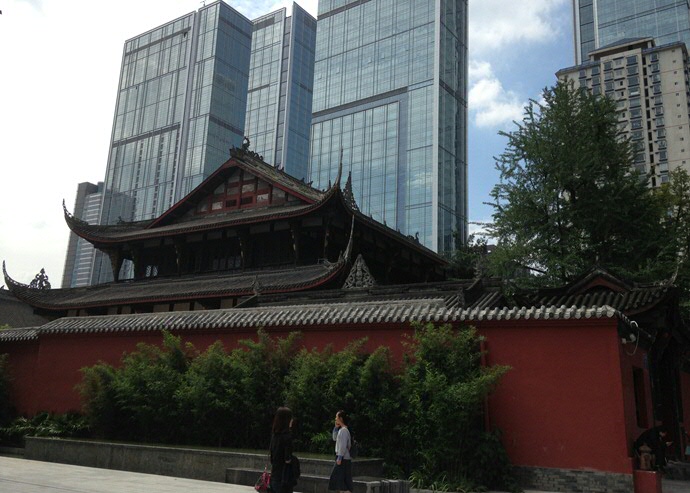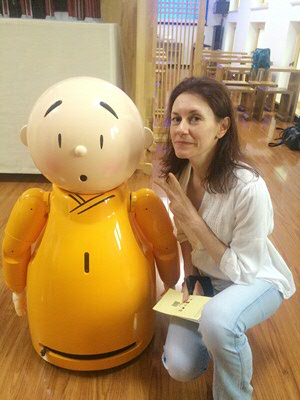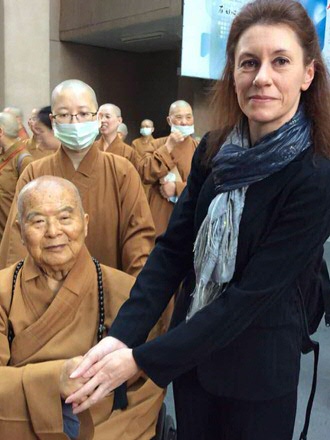Bidden in modern China

In veel facetten is de invloed van China op de Westerse wereld groeiende. Wat weten wij eigenlijk van dit immense land? Wie het moderne China wil begrijpen, kijke volgens Stefania Travagnin door de lens van religie. Alumnus Remko Tanis, die als China-correspondent zes jaar in Shanghai woonde en tot voor kort in Singapore, sprak met haar.
De boeddhistische tempel van Jing’an (Vrede en Rust) staat al acht eeuwen op dezelfde plek in Shanghai. In de dertiende eeuw was de omgeving vredig, rustig. Tegenwoordig wordt de tempel aan alle kanten overspoeld door het 21ste-eeuwse China. Letterlijk álle kanten: eronder reizen dagelijks minstens een miljoen mensen via het metrostation. Op straatniveau wordt de tempel omringd door winkels en restaurants. Er boven torenen wolkenkrabbers met kantoren en luxe hotels. r is niets religieus aan. Niet vreemd, in een land waar de al zeventig jaar regerende Communistische Partij fervent atheïstisch is. Toch is religie volgens Stefania Travagnin de juiste lens om door te kijken voor wie het moderne China wil begrijpen. ‘De seculiere en spirituele wereld zijn in China altijd met elkaar verweven geweest’, vertelt ze. Ze is even in Groningen, tussen twee reizen naar Taiwan door. ‘China is een groot, divers land met minstens vijftig etnische groepen en talloze religieuze stromingen. Het heeft een ontzettend complex verleden. Wat impliceert dat het heden ook complex is. Het is onmogelijk dit land te begrijpen zonder naar de cultuur en dus de religies te kijken.’

Praten met een robot-monnik
Maar eerst dit: ‘Religie is een westers begrip,’ zegt Travagnin. ‘In het Chinees kreeg het pas betekenis met de komst van het christendom. Boeddhistische monniken vroegen zich toen af of zij ook bij een religie hoorden, of meer bij een wetenschap, of een filosofie. Of bij al die dingen. Of bij niet één.’ Het vloeit in elkaar over. Net als de diverse religieuze stromingen dat doen in China. ‘In het Westen ben je óf christen, óf moslim, óf joods. Het is heel exclusief. In China is dat compleet anders. Een Chinees kan gaan bidden in een boeddhistische tempel en een dag later in een taoïstische. Als er toevallig een confuciaanse tempel in de buurt is, ga je daar heen. Of je zegt je gebeden online via de app van een tempel. Veel tempels hebben een QR-code. Scan die met je telefoon en je communiceert met een monnik, echte of een robot. Maakt niet uit hoe of waar: hoe meer je bidt, hoe beter.’ Die vloeiende overgangen tussen religieuze stromingen en methodes fascineren Travagnin. ‘Het is een mooie les voor het Westen, waar de scheiding tussen religies zo zwart-wit is. En bij diverse tempels bidden, betekent dat je altijd goed zit!’
Marco Polo
Travagnin groeide op in Venetië. ‘Als Italiaanse werd ik katholiek opgevoed, maar mijn ouders gaven me de vrijheid ook naar andere dingen te kijken. Toen ik stopte met naar de kerk gaan, vonden ze dat prima.’ Door haar jeugd heen duwden diverse factoren haar richting het Oosten. ‘Ik kom uit Venetië en ben groot fan van Marco Polo. Venetië ís Marco Polo, dus dat speelde sowieso mee.’ Als zesjarige keek ze elke dag een half uur naar Japanse tekenfilms op tv. ‘Ik ken nog steeds alle liedjes uit mijn hoofd. Ik ging dan naar mijn moeder in de keuken en zei dat ik rijst wilde eten. Maar het bleef pasta.’ Als kind ging ze niet, zoals anderen, op zwemmen of ballet. Travagnin koos voor de enige karateschool in de stad. ‘De middelbare school was fantastisch, maar je leerde vooral over het Westen. Plus een beetje over de koloniën in Afrika. Het enige wat je over Azië hoorde, ging over de Opiumoorlogen in China.’ Daarom koos ze voor de studie sinologie aan de Ca’Foscari University of Venice. ‘Ik had zin om alles wat ik wist over het Westen te laten botsen, in gesprek te laten gaan, met nieuwe kennis over het Oosten. Een studie Chinese taal en geschiedenis brengt je direct in het hart van die regio.’
Atheïsme
Terug naar Shanghai. De geur van ritueel verbrande wierook stijgt hardnekkig uit boven de commerciële lawine die de Jing’an tempel bedelft. De tempel wordt nog steeds van ’s ochtends tot ’s avonds druk bezocht. Het Han-boeddhisme leeft, wat tegenstrijdig lijkt met de geluiden uit Beijing. De Communistische Partij zal nooit erkennen dat haar autoriteit samenhangt met iets wat ook maar in de buurt komt van ‘het hemelse mandaat uit het keizerrijk’. In november bewees Chen Xi, leider van het Organisatorisch Bureau van de Partij, dat atheïsme het uitgangspunt blijft. Hij zei dat het gevaarlijk is in ‘geesten en goden’ te geloven, in plaats van in Marx en Lenin. Het enige geloof dat telt, aldus Chen, is een rotsvast vertrouwen in Xi Jinping als middelpunt van de Partij. Fascinerend, vindt Travagnin. ‘Xi gebruikt religieuze dynamieken om een cultus rondom zichzelf te kweken. Precies wat Mao deed.’

Moreel vacuüm
Maar in tegenstelling tot Mao ziet Xi religie, of in elk geval het Han-boeddhisme, niet als bedreiging, maar als handig instrument. ‘China kampt met een moreel vacuüm,’ zegt Travagnin. ‘Nieuwe generaties zijn de oude confuciaanse waarden kwijt. Respect voor ouderen, elkaar helpen, de samenleving als harmonieus geheel: wat vroeger werkte, is verdwenen. Mensen zijn verward, zoeken een identiteit. Mao’s Culturele Revolutie heeft oude waarden tot op het bot uitgekleed, vernietigd. Maar zonder waarden werkt de samenleving niet. De Partij probeert dat nu om te draaien door de principes van Confucius, die in het DNA van de Chinese beschaving zitten, opnieuw te promoten.’ Han-boeddhisme sluit volledig aan op het confucianisme en is daarin anders dan het ‘oorspronkelijke’ boeddhisme uit India. ‘In het Engels noemen ze het humanistisch boeddhisme. Dat slaat nergens op, maar het komt erop neer dat het een hele praktische vorm van het origineel is. Het gaat veel meer om waarden die nuttig zijn in de omgang met andere mensen en wat goed is voor de maatschappij, dan over hogere sferen of een leven na de dood.’ De Partij gebruikt het Han-boeddhisme ook om het nationalisme aan te wakkeren. ‘Dat kan, omdat elke tempel is aangesloten bij een overkoepelende organisatie die het beleid afstemt met de Partij. Op elke tempel zie je dezelfde vier Chinese karakters: ai guo, ai jiao. Hou van je land, hou van je religie. Wie Han-boeddhist wil zijn, moet die vier karakters respecteren.’
Online rituelen
Travagnin werkt momenteel aan een driejarig onderzoeksproject in de provincie Sichuan. Het is een regio waar islam, protestantisme, katholicisme, boeddhisme en taoïsme elkaar kruisen. Ze leidt het onderzoek samen met Elena Valussi van de Loyola University in Chicago. ‘We willen in kaart brengen hoe de diverse religieuze netwerken elkaar beïnvloeden. We kijken niet vanuit de instituten of de leiders, maar juist bottom-up: vanuit de bevolking.’ Het volgt op onderzoek dat ze deed naar het gebruik van moderne media door religieuze stromingen in China. ‘De apps en websites waarmee tempels jongeren aan zich proberen te binden, breken het gemeenschapsgevoel op. Mensen komen niet meer samen. Wellicht is dat de reden dat de overheid deze online rituelen zo promoot. Als iedereen op z’n eigen scherm bidt, zijn dat minder echte bijeenkomsten die in de gaten moeten worden gehouden.’
Stefania Travagnin (1975) is Rosalind Franklin Fellow en sinds 2013 assistent professor Religion in Asia en oprichter en directeur van het Centre for the Study of Religion and Culture in Asia aan de Faculteit Godgeleerdheid en Godsdienstwetenschap van de RUG. Ze is ook visiting professor aan de Faculty of Missiology van de Pontificia Università Urbaniana in Vaticaanstad. Daarvoor was Travagnin assistent-professor aan achtereenvolgens universiteiten in Missouri (VS), Saskatchewan (Canada), Pennsylvania (VS) en Manchester (VK). In 2009 promoveerde ze aan de University of London. In haar geboortestad Venetië studeerde ze in 2000 summa cum laude af met een major in Chinese taal, religie en filosofie en een minor in Hindi en Indiase religies en filosofie. Naast Italiaans spreekt Travagnin vloeiend Engels en enkele Chinese dialecten en is ze het Japans, Hindi, Sanskriet, Spaans, Frans en Duits vaardig. Ze werkt nog aan Koreaans en Nederlands.
Dit artikel is overgenomen uit alumnimagazine Broerstraat 5 van December. Auteur: Remko Tanis
